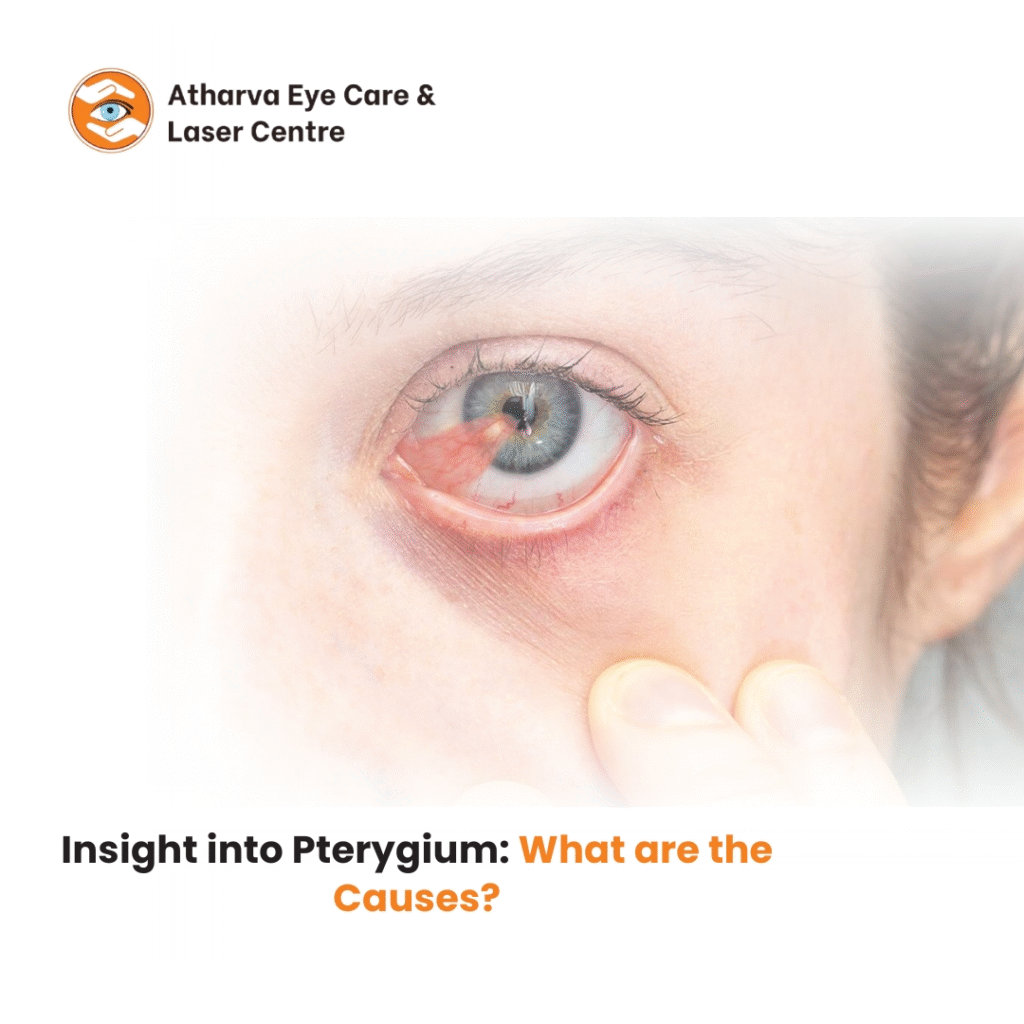- October 25, 2025
- By: atharvaeyeclinic.com
- No Comments
Insight into Pterygium: What are the Causes?
Eye health is vital to our overall well-being, yet many conditions affecting the eyes often go unnoticed until they cause discomfort. One such condition is Pterygium — a growth on the eye that is common in regions with high sun exposure. While it may sound alarming, understanding its causes, symptoms, and treatment options can help in early management and prevention.
In this blog, we will take a closer look at what pterygium is, what causes it, and how it can be treated effectively.
What is Pterygium?
Pterygium, also known as “surfer’s eye”, is a non-cancerous growth of pink, fleshy tissue on the conjunctiva (the clear membrane covering the white part of the eye). This growth often starts at the inner corner of the eye and may extend toward the cornea.
In its early stages, a pterygium may not cause noticeable problems. However, if it grows larger, it can cause irritation, redness, and even interfere with vision if it reaches the cornea.
Causes of Pterygium
The exact cause of pterygium is not fully understood, but several factors contribute to its development. The most common causes include:
- Exposure to UV Light
- The leading cause of pterygium is prolonged exposure to ultraviolet (UV) rays from the sun.
- People who spend long hours outdoors, especially in sunny climates, are at a higher risk.
- This is why the condition is often referred to as “surfer’s eye,” as it commonly affects people who work or play in outdoor, sun-drenched environments.
- Environmental Irritants
- Dust, wind, smoke, and dry air can irritate the eyes and increase the likelihood of pterygium formation.
- People living in dry, windy, or sandy regions are more prone to the condition.
- Chronic Eye Irritation
- Frequent eye irritation or inflammation due to allergies or pollutants can contribute to the development of pterygium.
- Genetic Predisposition
- In some cases, genetics may play a role, making certain individuals more susceptible.
- Age and Gender
- Pterygium is more common in adults over 30 and tends to affect men slightly more often than women, possibly due to greater outdoor activity exposure.
Symptoms of Pterygium
While small pterygia may not cause major problems, larger or progressive ones can lead to noticeable symptoms. These include:
- Redness and inflammation
- Burning or itching sensation in the eyes
- A gritty or foreign-body feeling
- Blurred vision if the growth extends onto the cornea
- Cosmetic concerns due to visible tissue growth on the eye
In severe cases, the pterygium can distort the shape of the cornea, leading to astigmatism and further vision problems.
Who is at Risk?
Certain groups of people are more likely to develop pterygium, including:
- Outdoor workers such as farmers, construction workers, or fishermen
- Athletes like surfers, swimmers, and cyclists
- People living in sunny or tropical regions
- Individuals exposed to dusty or polluted environments regularly
How is Pterygium Diagnosed?
Diagnosis is usually simple and requires a routine eye examination. An eye specialist can detect pterygium through a slit-lamp examination. In cases where vision is affected, additional tests may be conducted to check corneal involvement.
Treatment Options for Pterygium
The treatment for pterygium depends on its size, symptoms, and whether it is affecting vision.
- Observation and Monitoring
- Small, painless pterygia often do not require immediate treatment.
- Regular monitoring by an eye specialist ensures that the growth does not progress to the cornea.
- Medication
- Lubricating eye drops can relieve dryness and irritation.
- Anti-inflammatory eye drops may be prescribed to reduce redness and swelling.
- Surgical Removal
- If the pterygium grows large enough to affect vision, cause discomfort, or create cosmetic concerns, surgery may be recommended.
- The procedure involves carefully removing the growth and often grafting healthy conjunctival tissue to prevent recurrence.
- Lifestyle and Protective Measures
- Wearing UV-protective sunglasses and wide-brimmed hats helps reduce sun exposure.
- Avoiding dusty, smoky, and windy environments as much as possible.
- Using artificial tears to keep the eyes moist and comfortable.
Can Pterygium Be Prevented?
While not all cases of pterygium can be prevented, adopting certain habits can significantly reduce the risk:
- Protect your eyes from UV rays by wearing sunglasses with 100% UVA and UVB protection.
- Use safety glasses in dusty or windy environments.
- Keep your eyes lubricated with artificial tears in dry conditions.
- Avoid prolonged exposure to direct sunlight, especially during peak hours.
Living with Pterygium
For many people, pterygium is more of a cosmetic concern than a health risk. However, when left untreated, it can grow and interfere with vision. With modern treatments available, especially surgical removal with advanced techniques, outcomes are generally excellent, and recurrence rates can be minimized.
Regular check-ups with an ophthalmologist are essential for monitoring progress and ensuring timely treatment if needed.
Conclusion
Pterygium is a common eye condition caused mainly by prolonged UV exposure and environmental factors. While often harmless in its early stages, it can progress and lead to discomfort, irritation, and vision problems if untreated. Protecting your eyes from the sun, dust, and dryness is the best preventive measure.
At Atharva Eye Clinic, Kalyan, we provide expert diagnosis and treatment for pterygium and other eye conditions. With personalized care and advanced treatment options, we ensure your vision remains clear, comfortable, and healthy.

